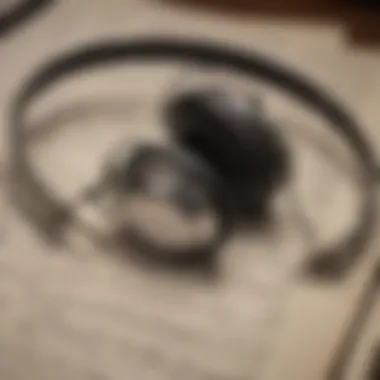The Musical Journey of Silver Linings Playbook


Intro
The world of cinema is often a melting pot of visual grandeur and emotional resonance, and few elements elevate this experience quite like the soundtrack. Silver Linings Playbook, directed by David O. Russell, is no exception. The film's carefully curated music reflects the narrative's themes of love, struggle, and redemption, blending seamlessly with its character-driven storytelling. The soundtrack serves not just as background noise but as a vital component that mirrors the emotional journey of its characters.
In this exploration, we will traverse the intricate layers of the film's soundtrack, shedding light on key artists and songs that contribute to its overall impact. By understanding how music ties into the narrative and elevates feelings, Silver Linings Playbook morphs into not just a visual treat but an auditory one as well.
Artist Profile
Biography and Background
Several artists grace the Silver Linings Playbook soundtrack, each bringing their unique flavor to the mix. One prominent figure is David Bowie, whose eclectic musical style has influenced countless musicians across genres. Born in London, Bowie’s career spanned over five decades, marked by consistent reinvention and artistic exploration. His work weaves through styles from glam rock to soul, showcasing a versatility that transcends mere genre boundaries.
Another significant contributor is The Black Keys, a duo known for their gritty sound characterized by a fusion of rock and blues. Hailing from Akron, Ohio, Dan Auerbach and Patrick Carney launched their career in the early 2000s and have since crafted a discography that resonates deeply with both critics and fans alike.
Major Influences and Inspirations
Both Bowie and The Black Keys draw on a range of musical influences that shine through their contributions in the film. Bowie's avant-garde style and penchant for theatricality pull from glam rock, art pop, and even electronic music, creating a rich tapestry that inspires a swath of modern artists. His tracks often explore themes of identity and existential musings, mirroring the film's deep engagement with personal struggles.
Conversely, The Black Keys' sound pays homage to classic blues greats while infusing it with a modern twist. Their music resonates with grit and sincerity, ideal for evoking the emotional depth and turmoil depicted in Silver Linings Playbook. The combination of these artists in the film's soundtrack creates a diverse auditory landscape, inviting listeners to connect on multiple emotional levels.
"Music is a piece of art that goes in the ears straight to the heart." - Unknown
Song Analysis
Theme and Lyrics Breakdown
The soundtrack of Silver Linings Playbook features an array of songs that deftly underscore the film’s narrative arcs. For instance, the poignant lyrics in ‘My Cherie Amour’ by Stevie Wonder encapsulate longing and hope, paralleling the journeys of the main characters. The choice of this track highlights moments of vulnerability and desire, enriching the viewer's understanding of the emotional stakes.
Instrumentation and Composition
On the other hand, The Black Keys’ track ‘Little Black Submarine’ introduces an energetic guitar riff layered with soulful vocals that serve as a sonic backdrop to the characters' moments of conflict and resolution. The instrumentation, marked by a raw, unpolished feel, complements the film's themes of authenticity and struggle.
Incorporating diverse styles and sounds, the soundtrack ultimately guides the audience through the emotional ups and downs inherent in the characters' lives, enhancing the overall cinematic experience. Each choice—whether a gentle lullaby or an upbeat rock anthem—contributes to revealing the deeper layers of the film's narrative.
As we move further in our exploration, we will delve into specific song meanings and how artists continue to shape our understanding of soundtracks in modern cinema. Through this lens, we aim to appreciate not just the music itself but the essence of storytelling that it accompanies.
Foreword to Silver Linings Playbook
In the labyrinth of contemporary cinema, Silver Linings Playbook stands out as a film that intricately weaves the narrative of its characters with a vibrant and compelling soundtrack. The infusion of music isn’t just an accessory; it serves as an essential element that shapes the emotional landscape of the story. Within this article, the focus will be on exploring how the soundtrack enhances not just the cinematic experience, but also the thematic context that runs deep in the film's plot and character arcs.
Understanding the interplay between music and film can unveil layers of meaning that may otherwise go unnoticed. The soundtrack of Silver Linings Playbook is a collection that speaks directly to the heart, complementing the characters’ journeys toward healing and self-discovery. Furthermore, by examining the specific tracks chosen for this film, we can identify the bonds between music and emotion, illustrating their significance in capturing the viewer's attention and stirring their feelings.
One cannot overlook the considerable thought that went into the selection of each song, reflecting not only the diverse musical influences but also resonating with various audiences. In this section, we will embark on a journey to uncover the narrative significance of the film, followed by an exploration of how music operates as a pivotal tool in shaping films generally.
Overview of the Film's Plot
Silver Linings Playbook, released in 2012, is a film steeped in themes of mental health, love, and redemption. Directed by David O. Russell, it tells the story of Pat Solitano, played by Bradley Cooper, who returns to his parents’ home after a stint in a mental health facility. Pat is determined to reconcile with his estranged wife, yet his journey is complicated by his struggles with bipolar disorder and the toll it takes on his relationships. Along the way, he crosses paths with Tiffany, portrayed by Jennifer Lawrence—a young woman grappling with her own emotional turmoil. As the two navigate their respective challenges, they form a unique bond rooted in their shared experiences and vulnerabilities.
The plot interlaces the characters’ lives with the context of family dynamics, societal expectations, and the pursuit of happiness, all while confronting the stigmas surrounding mental illness. Music plays a crucial role in this journey, amplifying the emotional highs and lows as the characters seek silver linings amidst their struggles. The film mirrors the unpredictable rhythm of life, showcasing moments of joy, despair, and unexpected connections.
The Role of Music in Film
Music in film serves as an indispensable narrative device, subtly guiding audience response and elevating the storytelling process. In Silver Linings Playbook, every song isn’t merely a background score; rather, it acts as a voice for the characters' innermost feelings and thoughts. The careful selection of tracks provides a backdrop that enhances pivotal moments, helps to build tension, and heightens emotional resonance.
- Emotion Enhancement: Songs like ”My Cherie Amour” by Stevie Wonder evoke nostalgia and longing, paralleling Pat’s quest for reconnection.
- Character Development: The music reflects character traits and transformations; for instance, Tiffany’s fierce independence is echoed in more assertive musical choices that give voice to her strength.
- Thematic Reinforcement: The soundtrack encapsulates central themes of hope and resilience, driving home the message that love and support can lead to brighter tomorrows, much like the film's title suggests.


As viewers, we often find ourselves moved by the sync of visual storytelling with auditory experiences. It’s the kind of interplay that leaves a lasting imprint.
"Music acts like a magic key, to which the most tightly closed heart opens." - Maria von Trapp
The soundscapes chosen for Silver Linings Playbook not only fill the spaces but also frame the narrative, proving that song and story can coexist harmoniously. With this foundation, we set forth to explore the significant contributions of the soundtrack that not only resonate with the film’s context but also stand on their own in wider musical discourse.
Significance of the Soundtrack
The soundtrack of Silver Linings Playbook serves not just as background music; it embodies the essence of the film’s narrative and emotional landscape. Each track is meticulously selected, adding layers of meaning, and allows the audience to experience a deeper connection with the characters' journeys. The choice of music speaks volumes about the themes of resilience, love, and recovery, reinforcing the idea that life is a complex symphony of highs and lows.
Understanding the significance of this soundtrack helps grasp how music can elevate cinematic storytelling. Music can break down barriers that dialogue sometimes cannot, acting as a bridge between the viewer's emotions and the unfolding drama on screen. The interplay between music and narrative creates an integrated experience that enhances engagement, making it a focal point in understanding films.
Music as a Narrative Device
In film, music is more than just accompaniment; it acts as a narrative device that influences our perception of events. In Silver Linings Playbook, certain tracks highlight character emotions and shifts in conflict. For instance, when Pat listens to a song that resonates with his past, the viewers are not only given insight into his memories but also understand how these experiences shape his present actions. The music underscores the moments of tension or resolution, drawing audiences into the emotional core of the story.
Additionally, songs often act as markers for character development. As the story unfolds, shifts in the musical themes correspond to pivotal moments, guiding viewers through the emotional highs and lows the characters encounter. For example, the upbeat tempo of a track may express newfound hope when Pat and Tiffany begin to connect, signifying a shift towards positivity and healing.
Emotional Resonance of the Tracks
The emotional resonance in Silver Linings Playbook's soundtrack is palpable. Each selected song is like a brushstroke on a canvas, adding hues of joy, sorrow, and hope. The layered instrumentations and heartfelt lyrics allow viewers to feel a range of emotions viscerally.
A notable example is "My Mind is For Sale" by Jack Johnson, which encapsulates the feelings of confusion and searching for identity, perfectly mirroring Pat's internal battle. Listeners can find themselves empathizing with the characters, as the music creates a shared space for vulnerability.
"Music brings people together in ways that nothing else can – it's the universal language of the soul."
As such, the soundtrack plays a crucial role in eliciting emotional responses, reinforcing the film's themes of unity and togetherness. It transforms simple scenes into poignant memories that linger long after the credits roll, pushing audiences to reflect on the characters' experiences in relation to their own lives.
Featured Artists in the Soundtrack
The soundtrack of Silver Linings Playbook is a vibrant tapestry woven with the talents of various artists. Each track not only adds depth to the narrative but also showcases the diverse musical landscape of contemporary music. This synergy enhances the emotional and thematic richness of the film, making it essential to explore the contributions of the featured artists.
Notable Contributions from Established Artists
Several established artists lend their voices and styles to this soundtrack, creating a powerful auditory experience that resonates with viewers.
- David Bowie: His track "Space Oddity" encapsulates themes of isolation and longing, paralleling the struggles faced by the main characters. Bowie's ability to convey complex emotions through his music makes this inclusion impactful.
- The Black Keys: Known for their gritty blues-rock sound, they bring energy to pivotal scenes with their song "Lonely Boy." The rawness of their music captures the urgency prevalent in certain moments of the film, emphasizing the emotional rollercoaster the characters endure.
- Fiona Apple: With her haunting and poignant song "Every Single Night," Apple adds a layer of vulnerability. Her lyrical introspection aligns perfectly with the film’s emotional depth, mirroring the intricacies of the characters’ psyche.
Adding these well-known artists not only garners attention but also elevates the film, inviting audiences to engage with the music on multiple levels. Their established reputations bring a sense of recognition that enhances the viewing experience.
Emerging Artists and Their Impact
In contrast to the established names, the inclusion of emerging artists adds a refreshing dynamic to the soundtrack. Their contributions reflect new musical trends and introduce audiences to fresh sounds that complement the film's themes.
- Iggy Pop: While he’s certainly a recognizable figure, his ongoing evolution in music keeps him in the emerging category. His work in Silver Linings Playbook aligns with the film’s spirit of rediscovery and renewal, echoing the journeys of its characters.
- Django Django: The band's unique blend of surf rock and electronic elements, especially in the song "Default,” infuses a modern twist. This blend resonates with the film’s pacing and fresh narrative style, reflecting the unpredictability of life.
- The Shouting Matches: Founded by Justin Vernon of Bon Iver, their track "Avery Hill" represents the folk-rock soundscape that often goes unnoticed. This subtle inclusion provides a sense of authenticity, grounding the film’s more intense moments with a nuanced musical backdrop.
The impact of these emerging artists is notable, as their styles challenge conventional norms, bringing innovation to the soundtrack. They push boundaries, inviting audiences to explore sounds they might not typically encounter, thus enriching the film's auditory palette.
The blending of established and emerging talent within Silver Linings Playbook’s soundtrack is a testament to the ongoing evolution of music, reinforcing how varied artistic voices can enhance storytelling.
Engaging with the contributions of these versatile artists not only elevates the film but invites reflection on how music continues to shape our emotional landscapes.
Track Analysis
Understanding the soundtrack of Silver Linings Playbook goes beyond mere listening; it is about dissecting how each track weaves into the film's narrative fabric. This section focuses on the importance of analyzing individual songs within the film, allowing for a richer comprehension of the characters’ journeys and the emotions they evoke.


The analysis of tracks reveals not just the music, but the themes running throughout the film. Each song acts as a gateway into the psyche of the characters, providing insights that dialogue alone may not convey. Furthermore, examining the selection helps illustrate the filmmakers’ intent, highlighting the emotional peaks and valleys that correspond with story developments.
Key Tracks and Their Themes
A few standout tracks in the Silver Linings Playbook soundtrack exemplify the harmony between music and narrative. For instance:
- "My Body" by Young the Giant
This track serves as a backdrop for moments of revelation and acceptance. The lyricism captured in the chorus speaks to physical and emotional liberation, mirroring Pat's own journey toward self-acceptance. - "The Wind" by Cat Stevens
Introduced during a pivotal scene, this song encapsulates reflection and nostalgia, underlining a moment of quiet introspection. The ethereal quality of the music complements the film’s quieter, more contemplative moments, allowing the audience to digest the unfolding complexities of the characters. - "We Found Love" by Rihanna featuring Calvin Harris
This energetic anthem plays during a crucial dance scene, symbolizing Pat and Tiffany’s mounting chemistry. The upbeat vibe contrasts with their emotional struggles, juxtaposing levity with tension, which is a hallmark of their relationship throughout the film.
Each song not only punctuates key moments but amplifies the emotional weight and thematic messages embedded in the story.
Lyric Interpretation and Meaning
Delving into the lyrics of the featured songs unveils layers of meaning that contribute to the Silver Linings Playbook’s narrative complexity. Take "Healthy" by The Black Keys for example; its explosive energy reflects both chaos and confrontation, mirroring Pat’s tumultuous state of mind. The lyrics honestly address struggles, making it resonate deeply with the film’s overarching themes of mental health and recovery.
Moreover, the choice of lyrics often aligns with character arcs. Pat’s journey is marked by frustration and hope, and the music often encapsulates that duality.
Another noteworthy piece is “The Best Thing About Me Is You” by T-Bone Burnett and the T-Bone Burnett Band. This song, played during a critical turning point, showcases vulnerability and companionship, echoing how critical support systems are for both Pat and Tiffany.
"Lyrics transform sounds into stories, demanding attention and reflection in ways that visuals alone cannot."
In summary, analyzing the tracks of Silver Linings Playbook illuminates how music functions as more than just a backdrop; it acts as a intricate narrative device that shapes how viewers engage with and interpret the film’s emotional landscape.
Cultural Context of the Music
Understanding the cultural context of the music in Silver Linings Playbook is paramount. This section dives into how the soundtrack serves not just as an accompaniment to the film's narrative but also as a window into the broader cultural landscape during its release. The track selection mirrors not only the personal journeys of the characters but also the societal undercurrents that influence them.
Influences of Musical Genres
The soundtrack of Silver Linings Playbook is a rich tapestry woven with various musical genres. Each genre selected for the film contributes uniquely to the storytelling, reflecting the diverse experiences of the characters. For instance, the presence of classic rock and indie music resonates deeply with the protagonist's struggles and triumphs.
- Classic Rock: This genre, embodied by tracks from artists like The Black Keys, often evokes nostalgia and a sense of defiance, echoing the film's themes of resilience amidst adversity.
- Indie Music: Tracks from emerging artists provide a fresh and authentic sound, capturing the uncertainties of modern life and love, represented vividly through the film's young characters.
By incorporating these influences, the filmmakers create a cultural dialogue with the audience, allowing each song to reflect the emotional and narrative beats of the film while also grounding the experience in a specific musical heritage.
Connection to Broader Music Trends
The music in Silver Linings Playbook does not exist in isolation; it connects with broader music trends of the time. The film was released in an era when indie pop and alternative rock were gaining significant traction in mainstream media. The resurgence of vinyl records and the embrace of DIY culture influenced how artists approached their craft, leading to a distinct sound that finds its way into the film's score.
Moreover, the eclectic mix of tracks captures the audience's contemporary experiences, reflecting a generation grappling with complex emotions and relationships in a rapidly changing world. For example:
- The rise of digital music platforms allowed lesser-known artists to reach wider audiences, enabling filmmakers to feature a diverse range of sounds that highlight an authentic representation of modern life.
- Genres like folk and electronic music also surfaced, with tracks that emphasize both simplicity in melody and complexity in emotional depth, which align perfectly with the film's themes of mental health and interpersonal dynamics.
"Music can tell a story or punctuate a scene in ways that dialogue sometimes cannot, making its cultural relevance undeniable in a film that explores such emotional landscapes."
Overall, the cultural context of the music in Silver Linings Playbook enriches viewers' experience by embedding personal stories within the larger societal narrative, making it both a reflection of its time and a timeless exploration of human emotion.
The Soundtrack’s Reception
The reception of a film's soundtrack often provides a lens through which audiences can better understand the work as a whole. In the case of Silver Linings Playbook, the soundtrack not only complements the narrative but also plays a pivotal role in shaping viewer perception. The way music interacts with the emotions portrayed on screen can significantly alter an individual's connection to the characters and their journeys.
Understanding the reception involves examining critical analysis and audience feedback. Critics and film buffs often dissect how certain tracks underscore poignant moments, helping to emphasize the film's themes like recovery, love, and hope. Moreover, the way a soundtrack is received can influence the popularity of featured artists and sometimes, even introduce lesser-known talents to a wider audience.
Critical Acclaim and Analysis
Critics have been generally favorable towards the Silver Linings Playbook soundtrack. Many highlight its eclectic mix, which showcases a blend of both contemporary and classic tracks. This variety does more than just fill the background; it resonates with the film’s underlying narrative. For instance, the inclusion of songs like "My Body" by Young the Giant injects a youthful energy that echoes the characters' struggles and aspirations.


"Music has the ability to transform a moment, to make it linger in memory long after the screen fades to black."
The soundtrack's arrangement provides depth and texture to emotional scenes. Critics point to how Silver Linings Playbook capitalizes on the synergy between visuals and audio, creating a nuanced narrative experience. Each song is strategically placed within the film to elicit particular reactions, making the audience feel the highs and lows alongside the characters.
Additionally, some tracks are chosen not for their popularity but for their emotional impact. The song "The Wind" by Cat Stevens, for instance, serves as a contemplative backdrop during a turning point in the film, allowing for moments of reflection that help deepen the viewer’s understanding of the characters’ journeys.
Audience Responses and Interpretations
Audience reception often diverges from critical commentary, reflecting personal connections and interpretations. Many viewers resonate with the soundtrack on a deeply emotional level. For some, songs like "I’ve Just Seen a Face" by The Beatles may evoke memories of their own lives, allowing the film's narrative to parallel personal experiences.
Social media platforms have played a vital role in viewer discussions about the soundtrack. Platforms such as Reddit host myriad threads where fans dissect their favorite tracks, share personal stories linked to the music, and even recommend similar songs. This dialogue enriches the soundtrack's legacy, making it a shared experience rather than just a component of the film.
Moreover, the reception is not limited to just music aficionados but extends to those who may not typically analyze soundtracks. The emotional tug from the selected tracks often leads viewers to discuss how the music supported their understanding of plot twists or character development.
In summary, the soundtrack of Silver Linings Playbook does not merely accompany the film; it becomes an integral part of the storytelling process. The critical acclaim it receives is matched by the deeply personal interpretations viewers form, ensuring that the music remains a conversational touchstone long after the credits roll.
Comparative Analysis
Comparative analysis plays a crucial role in understanding the soundtrack of Silver Linings Playbook. By examining it in relation to other notable soundtracks, we gain insight not only into its unique characteristics but also how it fits into the broader landscape of cinematic music. This kind of analysis allows us to recognize trends, influences, and innovations that can shape our viewing experience and emotional connection to the film.
One of the primary benefits of such a comparative approach is pinpointing what makes the soundtrack of Silver Linings Playbook stand out. Soundtracks often serve as more than just background music; they can enhance narrative elements, set a tone, or signal changes in character dynamics. By contrasting this film’s music with others, we can observe how its blend of genres and artists contributes to its identity.
In addition, understanding similar soundtracks can highlight how certain musical motifs resonate across different narratives. For example, soundtracks that successfully blend pop music with orchestral arrangements often create a memorable auditory experience that mirrors the emotional cadence of the film.
Therefore, comparative analysis enriches our appreciation of Silver Linings Playbook, encouraging us to perceive the soundtrack not merely as an assortment of songs but as an integral part of the story itself.
Similar Soundtracks in Cinema
When we talk about soundtracks that mirror the thematic and emotional layers found in Silver Linings Playbook, a handful come to mind. For instance, the soundtrack of Garden State also uses an eclectic mix of alternative and indie rock to articulate complex emotions. Just like Silver Linings, it features artists who resonate deeply with younger audiences, focusing on themes of healing and personal growth.
Another notable soundtrack is from Almost Famous, which brings the music of the 1970s to life. Like Silver Linings Playbook, it carefully curates tracks that reflect the protagonist's journey, creating a nostalgic yet fresh listening experience. The use of classic rock in Almost Famous provides an emotional depth that echoes the blend of contemporary and classic styles seen in Silver Linings.
Film soundtracks like Eternal Sunshine of the Spotless Mind also deserve mention. This soundtrack takes a somewhat non-traditional approach, mixing dreamy and melancholic tracks. The connection here is the emotional undercurrents that both soundtracks explore, revealing the characters’ complex psyches through their respective musical landscapes.
Some comparable features include:
- Emotional Depth: Both Silver Linings Playbook and similar soundtracks weave emotional storytelling through their chosen tracks.
- Eclectic Mix: The blend of genres in such soundtracks highlights a diverse listening experience.
- Cohesive Themes: Like the balance of comedy and drama in Silver Linings, these soundtracks reflect their films’ narrative shifts deftly through music.
Distinct Features of Silver Linings Playbook’s Soundtrack
What differentiates the soundtrack of Silver Linings Playbook is its ability to seamlessly fuse various musical styles to communicate a rich narrative.
- Genre Blending: The film's soundtrack incorporates a mix of folk, rock, and even classical influences. The presence of artists like The Black Keys and David Bowie juxtaposes contemporary and classic sounds, resulting in a layered auditory experience.
- Emotional Authenticity: Each track is meticulously chosen to enhance crucial moments in the film. For example, the use of "The Boxer" by Simon & Garfunkel carries a sense of longing and introspection, deepening the audience's connection to the characters' emotional states.
- Curation of Lesser-Known Artists: The inclusion of emerging artists alongside established names showcases a diverse pool of talent and highlights how their contributions are essential in painting the film’s emotional landscape. This is seen in tracks by Talib Kweli, which provides social insight and lyrical depth, further enriching the narrative context.
- Strategic Use of Music in Pivotal Scenes: The soundtrack effectively crescendos in critical moments, driving the narrative forward. For instance, the upbeat tracks used during the dance sequences juxtapose the characters' struggles with moments of joy, reinforcing the film's central theme of finding hope amidst chaos.
In summary, while comparative analysis highlights similarities with other films, the Silver Linings Playbook soundtrack stands out through its genre diversity, emotional authenticity, and its thoughtful curation of tracks that resonate with the film’s overarching narrative.
Finale
In wrapping up our exploration of the soundtrack from Silver Linings Playbook, it becomes clear how crucial music is to the film’s overall storytelling. This unique blend of songs not only heightens emotional moments but intricately weaves itself into the fabric of the narrative.
Summary of Key Insights
The soundtrack operates as more than just background filler; it carries the story's weight by encapsulating the characters' emotional arcs. Each track was carefully selected to resonate with key scenes and themes, effectively enhancing the audience's understanding of the protagonist's journey. For example, the way "My Body is a Cage" by Arcade Fire underscores the internal struggles faced by the characters cannot be understated. It serves as an auditory reflection of their isolation, longing, and the desire for connection. This kind of meticulous curation of songs illustrates how emotion can be conveyed not just through dialogue, but through melody and lyrics.
Several insights emerge when looking at this soundtrack:
- Character Connection: Each song aligns with a character's emotional state, which fosters a deeper connection for viewers.
- Cultural Reflection: Utilizing a mix of retro hits and contemporary pieces mirrors the film’s exploration of nostalgia versus present realities.
- Thematic Depth: The intertwining of various musical genres amplifies themes of hope, recovery, and love, which are central to the plot.
Reflections on the Soundtrack's Legacy
Looking forward, the legacy of Silver Linings Playbook's soundtrack stands to influence both film and music. By showcasing how expertly chosen songs can enrich a narrative, it encourages filmmakers and musicians alike to prioritize collaboration. This necessity to synergize with sound reminds creators that music has a profound ability to evoke feelings, offering a sensory experience that visuals alone cannot achieve.
Moreover, as audiences consume media across varied platforms, the style and approach of this soundtrack could inspire future projects to embrace diverse musical selections that enhance storytelling. The subtle integration of different genres resonates powerfully with the audience, demonstrating that the right song at the right time can turn a simple scene into a memorable journey.







